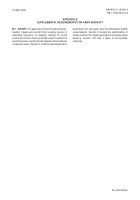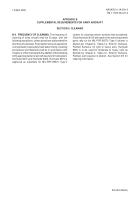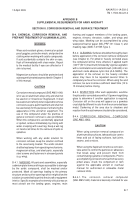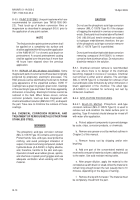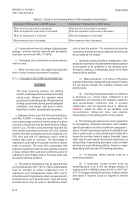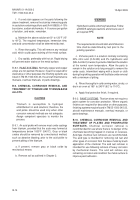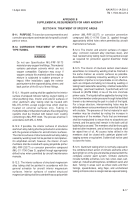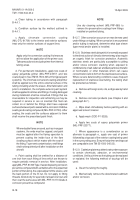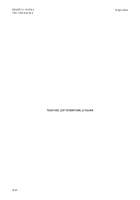TM-1-1500-344-23-2 - Page 213 of 240
B-11
NAVAIR 01-1A-509-2
TM 1-1500-344-23-2
15 April 2009
g. If corrosion is still evident, repeat paragraphs e.
and f.
h. Dry the part and immediately apply the protective
paint or other corrosion preventive finish.
B-6.2.2. Immersion Method (Acid Type). Use inhibited
phosphoric acid-type rust remover (MIL-C-10578
Type III) for small parts. Corrosion resistant steel tanks
are preferred for the immersion treatment.
a. Remove grease and oil as outlined in Chapter 2
of this manual.
b. Remove heavy rust by chipping and/or wire
brushing.
c. Mix the rust remover as described above.
d. Immerse the parts in the solution only long enough
to loosen the rust. For removal of heavy rust, the
solution can be heated to 140
°
F (60
°
C) maximum.
Agitate the parts in the solution to further increase the
rate of rust removal.
e. Rinse in a continuously overflowing cold water
rinse tank, if water rinse tank is available, or spray with
clean, preferably hot, water.
f. Dry the parts and immediately apply the final
protective paint or other corrosion preventive finish.
B-6.2.3. Immersion Method (Alkali Type). Use an alkali
type corrosion remover for removing corrosion from
small parts with or without attendant paint, grease, or
other surface coating. Corrosion removing compound,
sodium hydroxide base (MIL-C-14460) is suitable for
rust removal by simple immersion of the parts. The
compound will also remove grease, paint, and rust from
the parts, and may be used to clean copper and brass
and strip phosphate coatings. In addition, rust can be
removed from critical or machined surfaces with the
compound without causing dimensional change of the
part.
g. Prepare alkaline rust remover in accordance with
manufacturers instructions as printed on the container.
The usual concentration employed for Type I material is
five pounds per gallon of water. Carbon steel or corrosion
resistant steel tanks may be used.
h. Immerse parts in the rust remover solution. Rust
removal time varies with the extent of the rust.
Temperatures up to the boiling point of the solution may
be used to increase the rate of rust removal.
i. Rinse thoroughly in clean (preferably hot) water.
j. Dry thoroughly and immediately apply final
protective finish or other corrosion preventive compound.
B-6.3. PAINT SYSTEMS. See TM 55-1500-345-23 for
paint systems applicable to aircraft in general. In addition,
see the aircraft maintenance manuals overhaul manuals,
or parts drawings for specific paint systems.
B-7. CHEMICAL CORROSION REMOVAL AND
TREATMENT OF STAINLESS STEEL AND NICKEL
BASE ALLOYS.
CAUTION
Take care to protect surrounding unaffected
areas next to area being treated by avoiding
leakage of chemicals into recesses or
inaccessible area in order to prevent additional
damage from corrosion attack.
The heat-treatable straight-chromium alloys,
such as AISI Types 403, 410, and 420 are
susceptible to cracking when placed in pickling
solutions; therefore, corrosion removal by
brushing or grinding is recommended.
B-7.1. Chemical removal of corrosion is recommended
for severely corroded areas where there is no danger of
the chemicals becoming entrapped in recesses or
structural complexities or the possibility of damaging
surrounding metals and plating.
B-7.2. Corrosion removal procedure for installed
components which are not readily removable.
a. Protect adjacent unaffected areas not being
treated to prevent additional corrosive attack. When
internal corrosion is evident, the components shall be
removed and processed through an overhaul facility in
accordance with the specific directives.
b. Protect nearby non-corrosion-resistant steel
alloys, plated areas, copper-bronze alloys, aluminum
alloys, braided flexible lines, and operating mechanisms
to prevent the chemical treating solution from coming in
contact with those areas.
c. Remove all loose corrosion by brushing with
stainless steel wool or No. 400 carborundum paper.
Remove loose particles by wiping with a clean cloth
dampened with approved compliant cleaning solvents.
Back to Top

